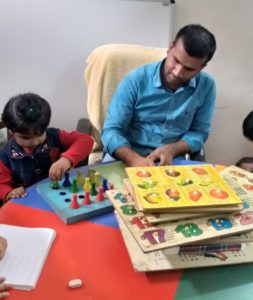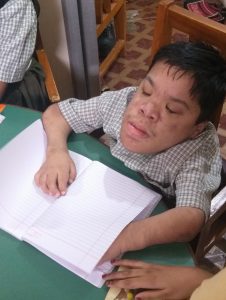Alia, 15, cannot move or talk. “She is totally dependent on me,” said her father Mohammad Asad, an electrician. “Her mother passed away almost nine years back. I have to remain with her most of the time”.
Even 35 years after the world’s worst industrial disaster that claimed 3787 lives in one night (unofficial estimates, however, put the number of deaths at over 20,000 till date, including those who died from gas related illnesses since) and left 500,000 permanently ill, victims of the Bhopal gas tragedy continue to suffer the effects of the deadly gas leak from the Union Carbide plant.
A local charity, Sambhavna Trust, had released a report in 2015 after three years of research which indicated that far too many children are being born with congenital defects to parents who suffered acute exposure to the toxic gas, and subsequently faced chronic exposure to contaminated water. The study covered over one lakh persons from about 20,000 families living close to the Union Carbide factory in colonies like Blue Moon colony, Shriram Nagar and Annu Nagar.
The tragedy is that not only the next generation born to those who survived the disaster are tormented by birth deformities, but also their children. The families now despair over the future of their sick children. The most common ailments among the survivors are cancer, pulmonary disease, asthma, diabetes, stomach and skin problems, and nephrotic diseases. They relive the disaster every day and most of them have to go to the hospital regularly. According to the government’s Bhopal Gas Tragedy Relief and Rehabilitation Department, the gas affected people get free medical treatment in one super-speciality hospital, two speciality and four general hospitals, two polyclinics and 14 dispensaries.
Rehabilitation efforts
Women like Champa Devi Shukla and Rashida Bee, managing trustees of the Chingari Trust, have for years been fighting for justice for the survivors and pushing for rehabilitation and schooling of children with congenital defects, born to survivors. In 2004, Rashida and Champa had formed the Chingari Trust as a rehabilitation centre for disabled children, using the money they got when they won the Goldman Environmental Prize for their work with gas-affected communities.
“More than 200 children with various kinds of disabilities due to their parent’s exposure to the deadly gas or contaminated water visit our rehabilitation centre every day,” said Rashida Bee. “We have a database of almost 1000 such children, but we don’t have the resources and funds to support all of them”.
Like Mohammad Zaid, who is 17 but looks like a small child. His body and mind have not developed with his years. His father was one of those who inhaled the deadly methyl isocyonate gas in 1984 and survived. The trust has been providing psychological support to these children to help them live a normal life and the condition of a few children has improved. Khatija, 11, is now able to walk with the support of her mother. “We were told by doctors that she had a mental problem,” said her mother Shahnaz. “Later, we were told about this centre run by Chingari Trust. She is improving slowly. I pray to the almighty that she should behave like normal children.”
The Chingari Trust, which provides physiotherapy, speech therapy, special education, occupational therapy and mid-day meals to the children, has identified children with different kinds of birth defects among the families exposed to the gas and contaminated groundwater. For instance, doctors found that a surprisingly large number of children suffered from cerebral palsy that results in complete disability. Doctors also noticed children with cleft lip and missing palate and with deficiencies in vision, hearing and mental functions. “We have been trying to reconstruct the lives, jobs, and health of the women and children devastated by Union Carbide,” said Rashida Bee.
Dr Sanjay Gaur, a physiotherapist with the trust for the last 10 years, said: “We have witnessed progress in these children. Many of them were not able to move earlier, but have now started to walk. Physiotherapy is definitely helping them.” Another physiotherapist Dr Zeba Ahmed said: “They are improving day by day with the help of exercises. A session with these children lasts for around 45 minutes, which also include activities. However, everything depends on the endurance of the individual.”
An uncaring government
Gas survivors allege successive governments have ignored them totally and have done little to help their medical rehabilitation and their need for additional compensation. On an average, a majority of survivors numbering about 574,000 received a one-time payment of Rs 25,000 for temporary disability. While the kin of the 5295 people who died on the night and in the immediate aftermath of the disaster, received only Rs 100,000 instead of Rs 233,000, the amount originally fixed by the government, as the number of dead turned out to be far higher than originally estimated.
The affected children too are not receiving any state help for their medical treatment or rehabilitation. Neither has there been any effort to make the most affected areas safe for residents. “Chemical wastes remain dumped in and around the premises of the Union Carbide factory and contaminate the water that people drink,” said activist Rachna Dhingra of Bhopal Group for Information and Action. “Children have been exposed to the deadly gas inside the wombs of their mothers who are passing it on to the next generation. The government has failed to fulfil its promise of providing piped water to these people.”
But the government refuses to accept the claims of these NGOs that the birth defects and other medical problems faced by the children and grandchildren of the gas leak survivors is due to the contaminated soil and water.
Chemicals left abandoned and unmaintained at the plant continue to pollute the groundwater. Pesticides, chemicals, and heavy metals are present in the groundwater in and around the abandoned Union Carbide factory and this water is consumed by people living in the densely populated surrounding areas. According to international environmental organization Greenpeace, over 20,000 people still live in the factory compound’s neighbourhood and are exposed to lethal chemicals through groundwater and soil contamination.
Nazia Khan, 39, lives in Qazi camp, a locality within a radius of a kilometre from the closed Carbide factory. “We have not been provided with proper medical facilities,” said Nazia, who belongs to the second generation of gas victims. “Our lives have been one of pain and illness. I suffer from asthma and my husband from tuberculosis. My mother had lost vision the night after the poisonous gas leaked. I lost my father and a sister in the tragedy. I have a son and daughter, but they are very weak and often ill.”
Greenpeace says a whole new generation continues to suffer from long-term health effects ranging from cancer, tuberculosis and congenital deformities apart from everyday maladies such as aches and pains, headaches, nausea, loss of appetite, rashes, fevers, eruptions of boils, dizziness and persistent fatigue. The Madhya Pradesh Pollution Control Board has found that the soil and groundwater of the area are contaminated with dangerous levels of mercury, nickel and pesticides like endrin, dieldrin, carbaryl, methoxychlor and other toxins that can cause birth defects. However, they are doing nothing about it.
Hazardous waste still lying around
Currently, 346 tonnes of hazardous toxic waste kept in sealed containers in the factory is yet to be disposed of. Over the years, authorities drew up plans to dispose of the waste at different locations, first at Pithampur in MP, then at Ankleshwar in Gujarat, then at a facility of the Defence Research and Development Organisation (DRDO) near Nagpur in Maharashtra and also at a German facility in Hamburg. But none of the plans materialised mainly due to stiff opposition from the local people at the sites chosen and concerns over the risk to public health and safety from incineration of the poisonous wastes.
Besides the sealed containers, it is estimated that another 27,000 tonnes of waste is lying in the open on the premises of the defunct factory, contaminating the air and groundwater. Some experts say no facility in India is capable of handling this waste.
Meanwhile, it seems that the priority for local MLA and Minister for Bhopal Gas Tragedy Relief and Rehabilitation, Arif Aqeel is to investigate alleged violation of the Foreign Contribution (Regulation) Act (FCRA) by NGOs working among the victims of the gas tragedy. He has recently directed the finance department to investigate alleged violations.
“These NGOs were not transparent about the funds they have received,” said Arif Aqeel. When asked about the conditions of the gas victims, Aqeel said: “The state government has been providing all kinds of facilities to the victims. Our priority is to ensure better medical care and facilities to gas victims, which we have been doing.”
A number of organizations and activists, who have been fighting tirelessly for the gas survivors all these years, now worry that the memories of that horrific incident may never be erased from the people’s memory, given the apathy of the state and central governments towards the continuing suffering of the gas survivors, their children and their grandchildren.
“I organise weekly meetings every Saturday at a city park to keep the victims going,” said activist Abdul Jabbar, who lost his mother, father and an elder brother to the after-effects of the gas tragedy. Keeping public memory alive is a critical feature of his activism. “It’s important we never forget the human cost of the Bhopal Gas Tragedy.”

